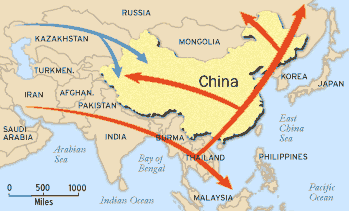



Modern genetic research have concluded that humans spread from the Middle East through Pakistan and India along the Indian Ocean coastline, arriving in Southeast Asia some 60,000 to 70,000 years ago. From there, the populations spread north and northwest into China, Siberia and eventually crossing the Bering Strait into North America.
Ended c. 11 000 years ago
The Paleolithic period ends with the last of the Ice Ages. The last Ice Age were at it's height about 70 000 years ago, began its retreat 17,000 years ago. The warm-up began abruptly, with the temperature rising sharply while most of the ice was still present. The last Ice Age ended about 11 000 years ago.
The most recent big cooling started about 12,700 years ago, right in the midst of our last global warming. This cold period, known as the Younger Dryas, is named for the pollen of a tundra flower that turned up in a lake bed in Denmark when it shouldn't have. Things had been warming up, and half the ice sheets covering Europe and Canada had already melted. The return to ice-age temperatures lasted 1,300 years. Then, about 11,400 years ago, things suddenly warmed up again, and the earliest agricultural villages were established in the Middle East. An abrupt cooling got started 8,200 years ago, but it aborted within a century, and the temperature changes since then have been gradual in comparison. Indeed, we've had an unprecedented period of climate stability.
As described in mythology Chinese civilization begins with Pangu, the creator of the universe, and a succession of legendary sage-emperors and culture heroes who taught the ancient Chinese to communicate and to find sustenance, clothing, and shelter.
By 125,000 years ago Homo sapiens had evolved from our ancestor species. Some of these early populations moved into parts of the globe where no hominid had ventured previously, and at a time when the intense cold of the Ice Age made life in those regions a considerable challenge. By the beginning of the last ice ages a modern man with recognizable Mongoloid features had appeared so, the whiplash climate changes of the last ice age affected people much like us.
These early men were skilled hunters, they knew fire and required social organization on the part of the hunters for successful capture. Clothing was essential to combat the freezing temperature and we may guess that their skill in making clothes increased considerably. The most primitive of these early men was Lantian man, and the most famous Beijing man, found by the Swedish Geologist Johan Gunnar Andersson.
It is likely that humans were so few in number during the Early Paleolithic that when preferred food sources became scarce, the usual response was to simply pick up and move to where things were better.
But as population increased in the late Middle Paleolithic and again in the Upper Paleolithic period of 40,000 to 12,000 years ago, and with it the competition for food, humans appear to have responded by adapting new and more sophisticated food-gathering technologies and social cooperation. Unfortunately most often singular lithic artifacts are used to represent the many complexes of Eurasia during the Upper Paleolithic period.
This disproportionate emphasis on stone tools obscures rather than illuminates the character of Upper Paleolithic life ways. It maintains the myth that stone was the key element in the technologies of most, if not all, late Ice Age populations. And since the most dramatic elements of lithic toolkits are often components of offensive weaponry, the emphasis on stone tools perpetuates the image of "man the big-game hunter."
By evidence from European investigation these early men were inventive and their technology became refined and developed to a high degree. For one example a successor of the Neanderthal people invented a way of punching fine blades from prepared flint blocks giving them an incredible 26 meters (85 feet) of cutting edge from a single kilogram (2 pounds) of starting material.
For example, what appear to be hunting nets, which presumably would have been used by both sexes and most age groups, have been documented in central Europe. This is a much more parsimonious explanation for the thousands of small-mammal bones found at Upper Paleolithic sites in the region than the traditional view of marauding groups of male hunters armed with small spears.
Yet conclusive evidence now exists that products based on plant fiber — cordage, basketry, netting, even bona fide textiles - were being produced in central Europe by at least 25,000 years ago. Elsewhere in Europe, the Near East, and the Far East, similar materials are in evidence only a few thousand years later. Thus fiber technology might end up much more important than stone.

Interesting external links: William H. Calvin, Ascent of Mind: Ice Age Climates and the Evolution of Intelligence.
The text is based on, CHINA - a Country Study by Federal Research Division, Library of Congress, Edited by Robert L. Worden, Andrea Matles Savada and Ronald E. Dolan. Research Completed July 1987. This version and Webpage © Jan-Erik Nilsson, Gothenburg, Sweden, 2002